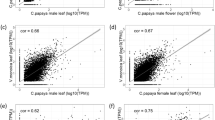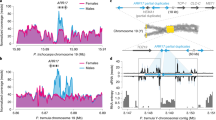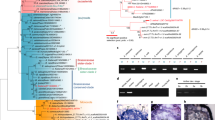Abstract
Sex chromosomes have repeatedly evolved from a pair of autosomes. Consequently, X and Y chromosomes initially have similar gene content, but ongoing Y degeneration leads to reduced expression and eventual loss of Y genes1. The resulting imbalance in gene expression between Y genes and the rest of the genome is expected to reduce male fitness, especially when protein networks have components from both autosomes and sex chromosomes. A diverse set of dosage compensating mechanisms that alleviates these negative effects has been described in animals2,3,4. However, the early steps in the evolution of dosage compensation remain unknown, and dosage compensation is poorly understood in plants5. Here, we describe a dosage compensation mechanism in the evolutionarily young XY sex determination system of the plant Silene latifolia. Genomic imprinting results in higher expression from the maternal X chromosome in both males and females. This compensates for reduced Y expression in males, but results in X overexpression in females and may be detrimental. It could represent a transient early stage in the evolution of dosage compensation. Our finding has striking resemblance to the first stage proposed by Ohno6 for the evolution of X inactivation in mammals.
This is a preview of subscription content, access via your institution
Access options
Access Nature and 54 other Nature Portfolio journals
Get Nature+, our best-value online-access subscription
$29.99 / 30 days
cancel any time
Subscribe to this journal
Receive 12 digital issues and online access to articles
$119.00 per year
only $9.92 per issue
Buy this article
- Purchase on Springer Link
- Instant access to full article PDF
Prices may be subject to local taxes which are calculated during checkout


Similar content being viewed by others
References
Bachtrog, D. Y-chromosome evolution: emerging insights into processes of Y-chromosome degeneration. Nat. Rev. Genet. 14, 113–124 (2013).
Charlesworth, B. The evolution of chromosomal sex determination and dosage compensation. Curr. Biol. 6, 149–162 (1996).
Mank, J. E. Sex chromosome dosage compensation: definitely not for everyone. Trends Genet. 29, 677–683 (2013).
Gu, L, & Walters, J. Evolution of sex chromosome dosage compensation in animals: a beautiful theory, undermined by facts and bedeviled by details. Genome Biol. Evol. 9, 2461–2476 (2017).).
Muyle, A., Shearn, R. & Marais, G. A. The evolution of sex chromosomes and dosage compensation in plants. Genome Biol. Evol. 9, 627–645 (2017).
Ohno, S. Sex Chromosomes and Sex-Linked Genes (Springer: Berlin, 1967).
Kuroda, M. I., Hilfiker, A. & Lucchesi, J. C. Dosage compensation in Drosophila—a model for the coordinate regulation of transcription. Genetics 204, 435–450 (2016).
Albritton, S. E. et al. Sex-biased gene expression and evolution of the X chromosome in nematodes. Genetics 197, 865–883 (2014).
Ercan, S. Mechanisms of X chromosome dosage compensation. J. Genomics 3, 1–19 (2015).
Pessia, E., Engelstädter, J. & Marais, G. A. B. The evolution of X chromosome inactivation in mammals: the demise of Ohno’s hypothesis? Cell. Mol. Life Sci. 71, 1383–1394 (2014).
Disteche, C. M. Dosage compensation of the sex chromosomes. Annu. Rev. Genet. 46, 537–560 (2012).
Julien, P. et al. Mechanisms and evolutionary patterns of mammalian and avian dosage compensation. PLoS Biol. 10, e1001328 (2012).
Pessia, E., Makino, T., Bailly-Bechet, M., McLysaght, A. & Marais, G. A. B. Mammalian X chromosome inactivation evolved as a dosage-compensation mechanism for dosage-sensitive genes on the X chromosome. Proc. Natl Acad. Sci. USA. 109, 5346–5351 (2012).
Whitworth, D. J. & Pask, A. J. The X factor: X chromosome dosage compensation in the evolutionarily divergent monotremes and marsupials. Semin. Cell Dev. Biol. 56, 117–121 (2016).
Wagschal, A. & Feil, R. Genomic imprinting in the placenta. Cytogenet. Genome Res. 113, 90–98 (2006).
Patten, M. M. et al. The evolution of genomic imprinting: theories, predictions and empirical tests. Heredity 113, 119–128 (2014).
Rautenberg, A., Hathaway, L., Oxelman, B. & Prentice, H. C. Geographic and phylogenetic patterns in Silene section Melandrium (Caryophyllaceae) as inferred from chloroplast and nuclear DNA sequences. Mol. Phylogenet. Evol. 57, 978–991 (2010).
Chibalina, M. V. & Filatov, D. A. Plant Y chromosome degeneration is retarded by haploid purifying selection. Curr. Biol. 21, 1475–1479 (2011).
Bergero, R. & Charlesworth, D. Preservation of the Y transcriptome in a 10-million-year-old plant sex chromosome system. Curr. Biol. 21, 1470–1474 (2011).
Muyle, A. et al. Rapid de novo evolution of X chromosome dosage compensation in Silene latifolia, a plant with young sex chromosomes. PLoS Biol. 10, e1001308 (2012).
Kazama, Y. et al. SlWUS1; an X-linked gene having no homologous Y-linked copy in Silene latifolia. G3 (Bethesda) 2, 1269–1278 (2012).
Bergero, R, Qui, S, & Charlesworth, D. Gene loss from a plant sex chromosome system. Curr. Biol. 25, 1234–1240 (2015).
Papadopulos, A. S. T., Chester, M., Ridout, K. & Filatov, D. A. Rapid Y degeneration and dosage compensation in plant sex chromosomes. Proc. Natl Acad. Sci. USA. 112, 13021–13026 (2015).
Muyle, A. et al. SEX-DETector: a probabilistic approach to study sex chromosomes in non-model organisms. Genome Biol. Evol. 8, 2530–2543 (2016).
Ellegren, H. & Parsch, J. The evolution of sex-biased genes and sex-biased gene expression. Nat. Rev. Genet. 8, 689–698 (2007).
Malone, J. H. et al. Mediation of Drosophila autosomal dosage effects and compensation by network interactions. Genome Biol. 13, r28 (2012).
Veitia, R. A., Veyrunes, F., Bottani, S. & Birchler, J. A. X chromosome inactivation and active X upregulation in therian mammals: facts, questions, and hypotheses. J. Mol. Cell Biol. 7, 2–11 (2015).
Siroky, J., Castiglione, M. R., & Vyskot, B. DNA methylation patterns of Melandrium album chromosomes. Chromosome Res. 6, 441–446 (1998).
Wu, T. D. & Nacu, S. Fast and SNP-tolerant detection of complex variants and splicing in short reads. Bioinformatics. 26, 873–881 (2010).
Zemp, N. et al. Evolution of sex-biased gene expression in a dioecious plant. Nat. Plants 2, 16168 (2016).
Acknowledgements
This project was supported through ANR grant ANR-14-CE19-0021-01 to G.A.B.M, SNSF grant 160123 to A.W. and Czech Science Agency grant 16-08698S to R.H. We thank the EMBL Genomics Core Facility (EMBL, Heidelberg) for Y-chromosome sequencing. We thank B. Gaut, T. Giraud and J. Mank for comments on the manuscript.
Author information
Authors and Affiliations
Contributions
A.M., N.Z., A.W. and G.A.B.M. conceived the study and experimental design. N.Z. and A.W. prepared and sequenced the plant material. A.M. ran SEX-DETector on the RNA-seq datasets for the three tissues, analysed the data, prepared tables and figures, and wrote the Supplementary Information with input from the other authors. N.Z. generated the X-chromosome genetic map. R.C., J.V. and R.H. did the Y-chromosome flow cytometry sorting and sequencing. C.D. did the first assembly of the sorted Y chromosome and improved it with RNA-seq data with the help of C.F. A.M. did the blasts to validate the inferences of SEX-DETector. R.T. did the GO term analysis. A.M. and F.P. did the statistical analyses of the data. G.A.B.M. and A.M. wrote the main text of the manuscript with input from the other authors.
Corresponding author
Ethics declarations
Competing interests
The authors declare no competing interests.
Additional information
Publisher’s note: Springer Nature remains neutral with regard to jurisdictional claims in published maps and institutional affiliations.
Supplementary Information
Supplementary Information
Supplementary Text, Supplementary References, Supplementary Figures 1–16, and Supplementary Tables 1 and 3.
Supplementary Table 2
Mapping statistics. Library sizes (number of reads) and percentage of mapped reads of each individual.
Supplementary Table 4
Known sex-linked genes in S. latifolia. Gene names, transcripts and associated literature references are listed.
Supplementary Table 5
GO-terms and expression levels of seedling sex-linked transcripts. For each sex-linked transcript in seedlings, the mean Y over X expression ratio in males is given followed by the mean male over female expression, the mean paternal allele expression in females, the mean maternal allele expression in females and in males, the mean Y allele expression and the mean outgroup expression (S. vulgaris). This is followed by GO analysis output: number of hits, GO names, Enzyme names and InterPro GO names.
Rights and permissions
About this article
Cite this article
Muyle, A., Zemp, N., Fruchard, C. et al. Genomic imprinting mediates dosage compensation in a young plant XY system. Nature Plants 4, 677–680 (2018). https://doi.org/10.1038/s41477-018-0221-y
Received:
Accepted:
Published:
Issue Date:
DOI: https://doi.org/10.1038/s41477-018-0221-y
This article is cited by
-
Genome assembly of the basket willow, Salix viminalis, reveals earliest stages of sex chromosome expansion
BMC Biology (2020)
-
The distribution of epigenetic histone marks differs between the X and Y chromosomes in Silene latifolia
Planta (2019)
-
How to solve the gender expression gap
Nature Plants (2018)



